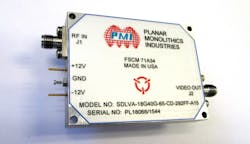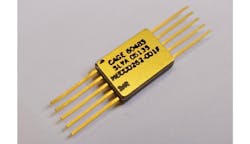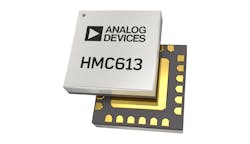Download this article as a .PDF
Signals can be elusively short-lived and signal analysis difficult in tactical applications. Many electronic defense systems rely on a component that is a combination of a detector and an amplifier, such as a detector log video amplifier (DLVA) or a successive detection log video amplifier (SDLVA), to sort low-level signals from such a crowed signal environment. A SDLVA essentially adds gain stages to a DLVA to increase its amplitude dynamic range.
These types of amplifiers often boost small, transient signal voltages in electronic-warfare (EW) and electronic-intelligence (ELINT) systems to levels that can be analyzed to determine a proper response (such as distinguishing a friend from a foe). With their logarithmic video amplification, these components are particularly effective at processing narrow pulses with large variations in amplitude, as typically found in environments with operational radar and EW systems.
SDLVAs are key components in a number of different receiver types where it is desirable to perform signal processing on received/captured signals without frequency translation, so that information can be known about those signals. This is a useful function for radar warning receivers (RWRs), EW receivers, and electronic-countermeasures (ECM) receivers.
When processing short pulses over a wide range of amplitude levels, SDLVAs and DLVAs must convert short-duration signals to proportional DC voltages that can be analyzed for information about the input signals. For that reason, it is important that a SDLVA or DLVA preserves the amplitude information of the original input signals, even when they may occupy a wide dynamic range and wide frequency range.
A DLVA can be as simple as a single-diode detector followed by one or more stages of amplification in order to detect and amplify low-level signals within a frequency range of interest. When a greater dynamic range is needed for low-level signals buried amidst higher-level signals in the same frequency range, a SDLVA is a more complex, multiple-stage version of a DLVA—with much greater dynamic range, as might be needed in particular applications, such as in a direct-finding (DF) receiver trying to pinpoint the location of a distant radar emitter.
When dynamic range is not critical, a DLVA with a 30- or 40-dB dynamic range may provide sufficient performance to help capture and process all signals present. However, modern signal environments, with their ever-increasing blend of pulsed and modulated signals, typically require more processing gain than a DLVA, in addition to the wide dynamic range provided by the multiple detection/logging stages of a SDLVA to effectively capture and decipher low-level signals amidst the surrounding signal clutter.
A SDLVA may employ six or seven detection stages to provide typically 10-dB detection capability per stage to capture and process signals from the surrounding signals and noise. In contrast to a DLVA, which involves signal detection and then amplification, a SDLVA employs multiple stages of RF gain and compression to provide an exponential transfer function from input to output ports. By combining enough gain stages, a SDLVA can handle a large, 60- or 70-dB dynamic range, with the contributions of each gain stage summed in a video amplifier for processing.
A third option exists between the simplicity (but limited dynamic range) of the DLVA and the greater dynamic range (but complexity) of the SDLVA: the hybrid or sequential DLVA, with multiple detector stages to increase dynamic range. Each detector is typically sensitive to different portions of the dynamic range, making it possible for a hybrid DLVA to respond to a wider dynamic range for a given frequency range than a standard DLVA.
How do the performance parameters of a typical SDLVA relate to its effectiveness in a typical system application, such as in a RWR or DF receiver? Assuming, first of all, that a SDLVA can cover a frequency range of interest, it should also provide the signal sensitivity and dynamic range to handle the different levels of signals expected to be received within that frequency range.
SDLVAs are typically specified in terms of sensitivity by a parameter known as tangential signal sensitivity (TSS), which is essentially the lowest-level signal within a frequency range that a SDLVA can repeatedly and accurately detect without additional front-end preamplification.
Speed is an important characteristic of a SDLVA since the amplifier must be capable of responding quickly to a constantly changing signal environment—typically processing short-duration pulses. A SDLVA is characterized by the duration of signals that it can process, from nanosecond pulses to continuous-wave (CW) signals.
The amplifier stages of some SDLVAs can be saturated by CW signals at sufficiently high levels, and many SDLVAs are characterized for their CW immunity and for how long and at how high levels of CW signals they can function without reaching a state of saturation and essentially becoming useless while saturated for detecting low-level pulsed signals.
In addition, even for short pulses, a SDLVA requires time to process a continuous flow of pulsed input signals. It must be capable of delivering output voltages in proportion to very fast pulsed signals. A SDLVA’s rise time establishes that it is capable of detecting and amplifying pulsed signals at least as short as that rise time. The SDLVA’s recovery time identifies how long the amplifier requires to change from a condition of full output power to a state where it is capable of detecting a low-level signal at the threshold of its dynamic range.
Modern DLVAs and SDLVAs come in many shapes and sizes, from packaged components to integrated-circuit (IC) die, affording system designers the flexibility to add functionality to a system as needed. For example, one of the industry’s long-running SDLVA suppliers, Planar Monolithics Industries (www.pmi-rf.com), offers a variety of packaged components in different form factors and performance levels, to allow system designers to add detection capability as required.
As an example, the SDLVA-18G40G-65-CD-292FF-A15 is a coaxial SDLVA with microwave/millimeter-wave frequency range of 18 to 40 GHz (Fig. 1). Based on GaAs IC technology, it sports a 2.92-mm female “K” connector at the input port and an SMA female connector at the output port. With a logging range of -63 to +2 dBm and nominal TSS of -67 dBm, this SDLVA is designed to detect extremely low-level pulses at high frequencies, maintaining log linearity within ±3 dB over its operating temperature range. It is also built for speed, with typical rise time of 8 ns and typical recovery time of 40 ns.
When lower-frequency coverage is needed, the firm’s SDLVA-50M18G-70 is an SDLVA with broad frequency range of 50 MHz to 18 GHz and outstanding TSS of -70 dBm (dynamic range of -70 to 0 dBm). In spite of including a voltage-variable detector circuit that maintains video output voltage within 5%, this broadband SDLVA measures just 2.3 × 2.2 × 0.4 in. with SMA female connectors.
When an even smaller SDLVA footprint is required, PMI also offers DLVAs and SDLVAs from DC through 40 GHz in surface-mount, multipin (Fig. 2), and even custom packaging. Amplifiers such as the SLVAC-06135M-MA08 cover typical dynamic range of 65 dB with typical logging accuracy of ±1.5 dB across the frequency range and dynamic range. The standard package measures only 0.75 × 0.75 in.
Monolithic semiconductor technology has also contributed to smaller SDLVAs. One of the most broadband SDLVAs in the industry is also one of the smallest, the HMC613LC4B from Analog Devices. Based on GaAs integrated-circuit (IC) technology acquired with Hittite Microwave Corp., the SDLVA is supplied in a 24-lead, 4 × 4 mm surface-mount-technology (SMT) package (Fig. 3), for ease of mounting in most circuits.
In spite of the small size, it performs well, with a 59-dB logging range, from -54 to +5 dBm, from 100 MHz to 20 GHz. It also delivers log linearity of ±1 dB and output frequency flatness of ±1.5 dB across the wide frequency range, with rise time of 4 ns, fall time of 18 ns, and recovery time of 26 ns. It operates from a single +3.3-V dc supply. When even smaller size and more broadband coverage is needed, the same company’s HMC813 SDLVA is supplied in chip form. With a 55-dB logging range from 1 to 26 GHz, it also operates on a single +3.3-V dc supply.
Of course, these are just a few samples of SDLVAs currently available as standard products from a number of manufacturers. Additional suppliers of DLVAs and SDLVAs include L3 Narda-MITEQ, Microphase Corp., Paciwave, Inc., and Teledyne Defence & Space.
Although DLVAs and SDLVAs are most often associated with defense electronics applications, such as RWRs, EW receivers, and DF receivers, they are widely used in commercial settings like test equipment that must detect and analyze signals over a wide dynamic range. They remain a trusted and reliable solution for achieving a wide dynamic range over a wide frequency range.




